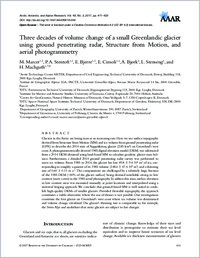Three decades of volume change of a small greenlandic glacier using ground penetrating radar, structure from motion, and aerial photogrammetry
- Marcer, M. Arctic Technology Centre ARTEK, Department of Civil Engineering, Technical University of Denmark, Kgs. Lyngby, Denmark - Institut de Géographie Alpine IGA, PACTE, Université Grenoble-Alpes, Grenoble, France
- Stentoft, P. A. Arctic Technology Centre ARTEK, Department of Civil Engineering, Technical University of Denmark, Kgs. Lyngby, Denmark - DTU Environment, Technical University of Denmark, Kgs. Lyngby, Denmark
- Bjerre, E. Arctic Technology Centre ARTEK, Department of Civil Engineering, Technical University of Denmark, Kgs. Lyngby, Denmark - DTU Environment, Technical University of Denmark, Kgs. Lyngby, Denmark
- Cimoli, E. Arctic Technology Centre ARTEK, Department of Civil Engineering, Technical University of Denmark, Kgs. Lyngby, Denmark - Institute for Marine and Antarctic Studies, University of Tasmania, Hobart, Australia
- Bjørk, A. Centre for GeoGenetics, Natural History Museum of Denmark, Kopenhagen K, Denmark
- Stenseng, L. DTU Space–National Space Institute, Technical University of Denmark, Department of Geodesy, Kgs. Lyngby, Denmark
- Machguth, Horst Arctic Technology Centre ARTEK, Department of Civil Engineering, Technical University of Denmark, Kgs. Lyngby, Denmark - Department of Geography, University of Zurich, Switzerland - Department of Geosciences, University of Fribourg, Switzerland
-
2017
Published in:
- Arctic, Antarctic, and Alpine Research. - 2017, vol. 49, no. 3, p. 411–425
English
Glaciers in the Arctic are losing mass at an increasing rate. Here we use surface topography derived from Structure from Motion (SfM) and ice volume from ground penetrating radar (GPR) to describe the 2014 state of Aqqutikitsoq glacier (2.85 km2) on Greenland's west coast. A photogrammetrically derived 1985 digital elevation model (DEM) was subtracted from a 2014 DEM obtained using land-based SfM to calculate geodetic glacier mass balance. Furthermore, a detailed 2014 ground penetrating radar survey was performed to assess ice volume. From 1985 to 2014, the glacier has lost 49.8 ± 9.4 106 m3 of ice, corresponding to roughly a quarter of its 1985 volume (148.6 ± 47.6 106 m3) and a thinning rate of 0.60 ± 0.11 m a-1. The computations are challenged by a relatively large fraction of the 1985 DEM (∼50% of the glacier surface) being deemed unreliable owing to low contrast (snow cover) in the 1985 aerial photography. To address this issue, surface elevation in low contrast areas was measured manually at point locations and interpolated using a universal kriging approach. We conclude that ground-based SfM is well suited to establish high-quality DEMs of smaller glaciers. Provided favorable topography, the approach constitutes a viable alternative where the use of drones is not possible. Our investigations constitute the first glacier on Greenland's west coast where ice volume was determined and volume change calculated. The glacier's thinning rate is comparable to, for example, the Swiss Alps and underlines that arctic glaciers are subject to fast changes.
- Faculty
- Faculté des sciences et de médecine
- Department
- Département de Géosciences
- Language
-
- English
- Classification
- Hydrology
- License
-
License undefined
- Identifiers
-
- RERO DOC 305669
- DOI 10.1657/AAAR0016-049
- Persistent URL
- https://folia.unifr.ch/unifr/documents/306048
Statistics
Document views: 108
File downloads:
- pdf: 173
